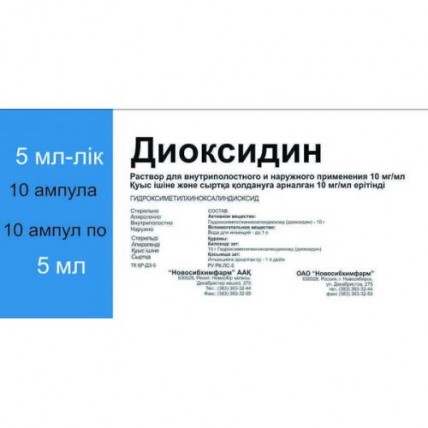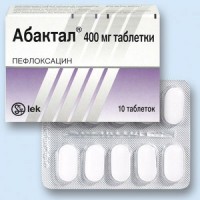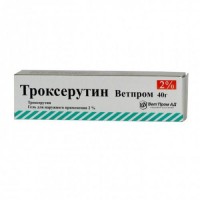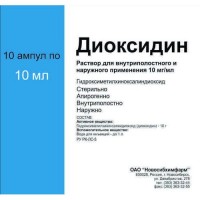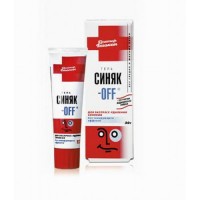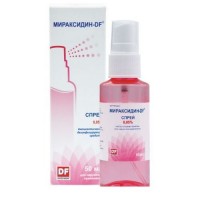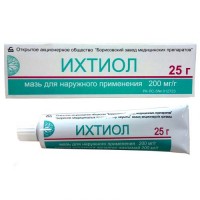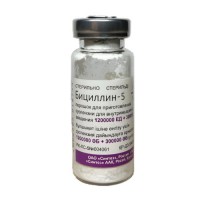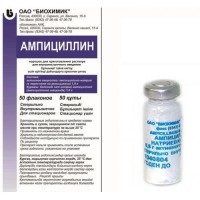Dioksidin 10 mg / ml solution for 5ml 10s intracavitary and external use
- $25.10
The instruction
for medical use of medicine
the Dioxidin
A trade name
the Dioxidin
the International unlicensed name
Is not present
the Dosage form
Solution for intracavitary and external use of 10 mg/ml,
Structure
of 1 l of drug
active agent contains 5 and 10 ml: hydroxymethylquinoxalinedioxide (dioxidin) of-10 mg
auxiliary substance: water for injections up to 1 ml.
The description
Transparent chartreuse liquid
Pharmacotherapeutic group
of Antiseptics and disinfecting drugs, other
the Code of automatic telephone exchange D08AX
the Pharmacological
Pharmacokinetics Well properties is soaked up at introduction to cavities and also from a wound surface at topical administration. Therapeutic concentration in blood remain during 4-6 h TCmax in blood - 1-2 h after single introduction. Well and quickly gets into all bodies and fabrics, it is removed by kidneys. At repeated introductions does not kumulirut.
The pharmacodynamics
Antibacterial drug of a broad spectrum of activity from group
of derivatives of quinoxaline, has chemotherapeutic activity in the infections caused
by Proteus vulgaris, Pseudomonas aeruginosa, Klebsiella pneumoniae, Escherichia coli, Shigella dysenteria, Shigella flexneri, Shigella boydii, Shigella sonnei, Salmonella spp., Staphylococcus spp., Streptococcus spp., pathogenic anaerobe bacterias (Clostridium perfringens) affects strains of the bacteria resistant to other khimiopreparata, including antibiotics.
Development of drug resistance of bacteria is possible. Processing of burn it is also purulent - necrotic wounds promotes faster clarification of a wound surface, stimulates reparative regeneration and regional epithelization and favorably influences a course of wound process.
Indications
the Purulent bacterial infections caused by sensitive microflora at inefficiency of other chemotherapeutic means or their bad shipping.
Intracavitary introduction
purulent processes in a chest and abdominal cavity, in purulent pleurisy, pleura empyemas, abscesses of lungs, peritonitises, cystitis, wounds with existence of deep purulent cavities (abscesses of soft tissues, phlegmons of pelvic cellulose, postoperative wounds of uric and biliary tract, purulent mastitis, etc.)
- prevention of infectious complications after bladder catheterization.
External use
superficial and deep wounds of various localization, is long not healing wounds and trophic ulcers, phlegmons of soft tissues infected burns, purulent wounds in osteomyelites.
The route of administration and doses
appoint the Dioxidin in the conditions of a hospital. Apply outwardly, in-band.
1% solution of a dioxidin cannot be used for intravenous administration, in view of instability of solution at storage at low temperatures.
Intracavitary introduction. Depending on its sizes enter into a purulent cavity a day from 10 to 50 ml of 1% of solution of the Dioxidin. Solution of the Dioxidin is entered into a cavity through a catheter, a drainage tube or the syringe.
The maximum daily dose for introduction to cavities of 70 ml of 1% of solution.
The drug is administered in a cavity usually once a day. According to indications the introduction of a daily dose in two steps is possible. At good tolerance it is possible to administer the drug daily within 3 weeks and more. If necessary in 1-1.5 months conduct repeated courses.
External use. Dioxidin solutions apply 0.1-1%. For receiving 0.1-0.2% of solutions ampoule solutions of drug part to the necessary concentration sterile 0.9% with solution of sodium of chloride or water for injections. For treatment of the superficial infected purulent wounds on a wound impose napkins, the moistened 0.5-1% Dioxidin solution. Deep wounds after processing, rykhlo tampon the tampons moistened with 1% Dioxidin solution, and in the presence of a drainage tube enter from 20 to 100 ml of 0.5% of solution of drug into a cavity.
Drug solutions in the form of baths apply 0.5-1% to treatment of deep purulent wounds in osteomyelitis (wounds of a brush, foot) or carry out special processing of a wound by drug solution within 15-20 min. (introduction to a solution wound for this term) with the subsequent imposing of bandages of 1% Dioxidin solution.
The dioxidin in the form of 0.1-0.5% of solutions can be used for prevention and treatment of an infection after surgeries. According to indications (patients with osteomyelitis) and at good tolerance the treatment can be carried out daily within 1.5-2 months.
At use for older persons it is necessary to consider age lowering of function of kidneys which can demand reduction of a dose of drug.
Side effects
At intracavitary introduction:
- a headache, a fever, fervescence
- nausea, vomiting, an abdominal pain, diarrhea
- convulsive reductions of muscles
- allergic reactions, it is rare - an acute anaphylaxis
- the photosensitizing effect (emergence of the pigmented spots on a body at influence of sunshine).
At external use:
- okoloranevy dermatitis, itching.
Contraindications
- hypersensitivity to a dioxidin
- adrenal insufficiency (including in the anamnesis)
- pregnancy and the period of breastfeeding
- children's and teenage age up to 18 years.
Medicinal interactions
At hypersensitivity to drug, apply the Dioxidin along with antihistaminic drugs or drugs of calcium.
The special
instructions Dioxidin are appointed only the adult. Before a course of treatment carry out test on tolerance of drug for what enter 10 ml of 1% of solution into cavities. At absence within 3-6 hours of by-effects (dizziness, a fever, fervescence), begin course treatment.
The dioxidin is appointed only at severe forms of infectious diseases or at inefficiency of other antibacterial drugs, including cephalosporins II-IV of generations, ftorkhinolon, karbapenem.
In chronic kidney disease apply with care, reduce a dose.
At emergence of a nevus pigmentosus increase duration of introduction of a dose till 1.5-2 o'clock, reduce a dose, appoint antihistaminic drugs or cancel the Dioxidin.
In case of loss of crystals of a dioxidin in ampoules with solution in the course of storage (at a temperature below 15 C) they are dissolved, heating ampoules in the boiling water bath when stirring to full dissolution of crystals (transparent solution). If when cooling till 36-38 About crystals do not drop out again, drug is good for the use.
The feature of influence of medicine on ability to run the vehicle or potentially dangerous mechanisms
during treatment needs to be careful at control of vehicles and occupation other potentially dangerous types of activity demanding the increased concentration of attention and speed of psychomotor reactions.
Overdose
At overdose of the Dioxidin the development of acute adrenal insufficiency is possible that demands immediate drug withdrawal and the corresponding replaceable hormonal therapy.
A form of release and packing
On 5 ml and on 10 ml in ampoules of neutral glass.
On 10 ampoules place in a box of cardboard. Put the instruction for medical use and the scarificator in each box ampoule.
On 5 or 10 ampoules in blister strip packaging from a film polyvinylchloride.
On 1 or 2 blister strip packagings together with the instruction for medical use in the state and Russian languages and the scarificator ampoule place in a pack from cardboard.
When packing ampoules with a ring of a break or a point of a break the scarificator ampoule is not put.
To Store storage conditions in the place protected from light at a temperature from 15 to 25 Pages.
To store out of children's reach!
Period of storage
2 years.
Not to apply after an expiration date.
Prescription status
Releases on the prescription.
JSC Novosibkhimpharm producer 630028, Russia, Novosibirsk, Dekabristov St., 275
Ph. (383) 211-92-03, fax (383) 211-92-04
Owner of the registration certificate: JSC Novosibkhimpharm,
the Russian Federation
the Address of the organization accepting claims for territories
of the Republic of Kazakhstan from consumers on quality of products (goods):
Valenta Aziya LLP, Almaty, ave. of Abay, ug. Ra St. of dostovets, 151/115,
business center Ala Tau office No. 702
Ph./fax 8727 334-15-52, E-mail:
To develop asia@valentapharm.com
for medical use of medicine
the Dioxidin
A trade name
the Dioxidin
the International unlicensed name
Is not present
the Dosage form
Solution for intracavitary and external use of 10 mg/ml,
Structure
of 1 l of drug
active agent contains 5 and 10 ml: hydroxymethylquinoxalinedioxide (dioxidin) of-10 mg
auxiliary substance: water for injections up to 1 ml.
The description
Transparent chartreuse liquid
Pharmacotherapeutic group
of Antiseptics and disinfecting drugs, other
the Code of automatic telephone exchange D08AX
the Pharmacological
Pharmacokinetics Well properties is soaked up at introduction to cavities and also from a wound surface at topical administration. Therapeutic concentration in blood remain during 4-6 h TCmax in blood - 1-2 h after single introduction. Well and quickly gets into all bodies and fabrics, it is removed by kidneys. At repeated introductions does not kumulirut.
The pharmacodynamics
Antibacterial drug of a broad spectrum of activity from group
of derivatives of quinoxaline, has chemotherapeutic activity in the infections caused
by Proteus vulgaris, Pseudomonas aeruginosa, Klebsiella pneumoniae, Escherichia coli, Shigella dysenteria, Shigella flexneri, Shigella boydii, Shigella sonnei, Salmonella spp., Staphylococcus spp., Streptococcus spp., pathogenic anaerobe bacterias (Clostridium perfringens) affects strains of the bacteria resistant to other khimiopreparata, including antibiotics.
Development of drug resistance of bacteria is possible. Processing of burn it is also purulent - necrotic wounds promotes faster clarification of a wound surface, stimulates reparative regeneration and regional epithelization and favorably influences a course of wound process.
Indications
the Purulent bacterial infections caused by sensitive microflora at inefficiency of other chemotherapeutic means or their bad shipping.
Intracavitary introduction
purulent processes in a chest and abdominal cavity, in purulent pleurisy, pleura empyemas, abscesses of lungs, peritonitises, cystitis, wounds with existence of deep purulent cavities (abscesses of soft tissues, phlegmons of pelvic cellulose, postoperative wounds of uric and biliary tract, purulent mastitis, etc.)
- prevention of infectious complications after bladder catheterization.
External use
superficial and deep wounds of various localization, is long not healing wounds and trophic ulcers, phlegmons of soft tissues infected burns, purulent wounds in osteomyelites.
The route of administration and doses
appoint the Dioxidin in the conditions of a hospital. Apply outwardly, in-band.
1% solution of a dioxidin cannot be used for intravenous administration, in view of instability of solution at storage at low temperatures.
Intracavitary introduction. Depending on its sizes enter into a purulent cavity a day from 10 to 50 ml of 1% of solution of the Dioxidin. Solution of the Dioxidin is entered into a cavity through a catheter, a drainage tube or the syringe.
The maximum daily dose for introduction to cavities of 70 ml of 1% of solution.
The drug is administered in a cavity usually once a day. According to indications the introduction of a daily dose in two steps is possible. At good tolerance it is possible to administer the drug daily within 3 weeks and more. If necessary in 1-1.5 months conduct repeated courses.
External use. Dioxidin solutions apply 0.1-1%. For receiving 0.1-0.2% of solutions ampoule solutions of drug part to the necessary concentration sterile 0.9% with solution of sodium of chloride or water for injections. For treatment of the superficial infected purulent wounds on a wound impose napkins, the moistened 0.5-1% Dioxidin solution. Deep wounds after processing, rykhlo tampon the tampons moistened with 1% Dioxidin solution, and in the presence of a drainage tube enter from 20 to 100 ml of 0.5% of solution of drug into a cavity.
Drug solutions in the form of baths apply 0.5-1% to treatment of deep purulent wounds in osteomyelitis (wounds of a brush, foot) or carry out special processing of a wound by drug solution within 15-20 min. (introduction to a solution wound for this term) with the subsequent imposing of bandages of 1% Dioxidin solution.
The dioxidin in the form of 0.1-0.5% of solutions can be used for prevention and treatment of an infection after surgeries. According to indications (patients with osteomyelitis) and at good tolerance the treatment can be carried out daily within 1.5-2 months.
At use for older persons it is necessary to consider age lowering of function of kidneys which can demand reduction of a dose of drug.
Side effects
At intracavitary introduction:
- a headache, a fever, fervescence
- nausea, vomiting, an abdominal pain, diarrhea
- convulsive reductions of muscles
- allergic reactions, it is rare - an acute anaphylaxis
- the photosensitizing effect (emergence of the pigmented spots on a body at influence of sunshine).
At external use:
- okoloranevy dermatitis, itching.
Contraindications
- hypersensitivity to a dioxidin
- adrenal insufficiency (including in the anamnesis)
- pregnancy and the period of breastfeeding
- children's and teenage age up to 18 years.
Medicinal interactions
At hypersensitivity to drug, apply the Dioxidin along with antihistaminic drugs or drugs of calcium.
The special
instructions Dioxidin are appointed only the adult. Before a course of treatment carry out test on tolerance of drug for what enter 10 ml of 1% of solution into cavities. At absence within 3-6 hours of by-effects (dizziness, a fever, fervescence), begin course treatment.
The dioxidin is appointed only at severe forms of infectious diseases or at inefficiency of other antibacterial drugs, including cephalosporins II-IV of generations, ftorkhinolon, karbapenem.
In chronic kidney disease apply with care, reduce a dose.
At emergence of a nevus pigmentosus increase duration of introduction of a dose till 1.5-2 o'clock, reduce a dose, appoint antihistaminic drugs or cancel the Dioxidin.
In case of loss of crystals of a dioxidin in ampoules with solution in the course of storage (at a temperature below 15 C) they are dissolved, heating ampoules in the boiling water bath when stirring to full dissolution of crystals (transparent solution). If when cooling till 36-38 About crystals do not drop out again, drug is good for the use.
The feature of influence of medicine on ability to run the vehicle or potentially dangerous mechanisms
during treatment needs to be careful at control of vehicles and occupation other potentially dangerous types of activity demanding the increased concentration of attention and speed of psychomotor reactions.
Overdose
At overdose of the Dioxidin the development of acute adrenal insufficiency is possible that demands immediate drug withdrawal and the corresponding replaceable hormonal therapy.
A form of release and packing
On 5 ml and on 10 ml in ampoules of neutral glass.
On 10 ampoules place in a box of cardboard. Put the instruction for medical use and the scarificator in each box ampoule.
On 5 or 10 ampoules in blister strip packaging from a film polyvinylchloride.
On 1 or 2 blister strip packagings together with the instruction for medical use in the state and Russian languages and the scarificator ampoule place in a pack from cardboard.
When packing ampoules with a ring of a break or a point of a break the scarificator ampoule is not put.
To Store storage conditions in the place protected from light at a temperature from 15 to 25 Pages.
To store out of children's reach!
Period of storage
2 years.
Not to apply after an expiration date.
Prescription status
Releases on the prescription.
JSC Novosibkhimpharm producer 630028, Russia, Novosibirsk, Dekabristov St., 275
Ph. (383) 211-92-03, fax (383) 211-92-04
Owner of the registration certificate: JSC Novosibkhimpharm,
the Russian Federation
the Address of the organization accepting claims for territories
of the Republic of Kazakhstan from consumers on quality of products (goods):
Valenta Aziya LLP, Almaty, ave. of Abay, ug. Ra St. of dostovets, 151/115,
business center Ala Tau office No. 702
Ph./fax 8727 334-15-52, E-mail:
To develop asia@valentapharm.com
